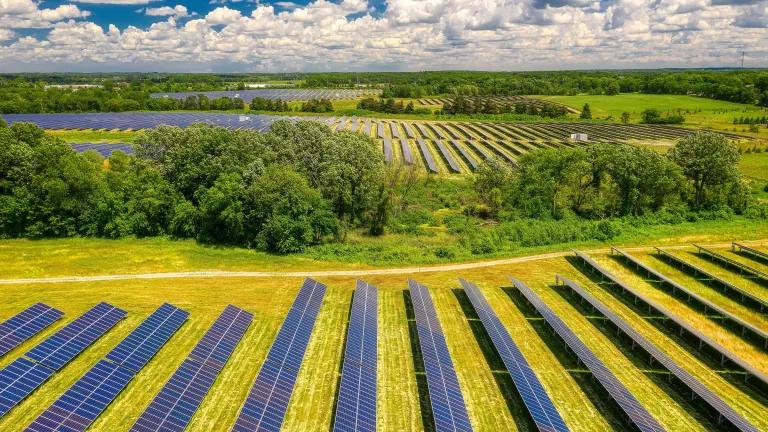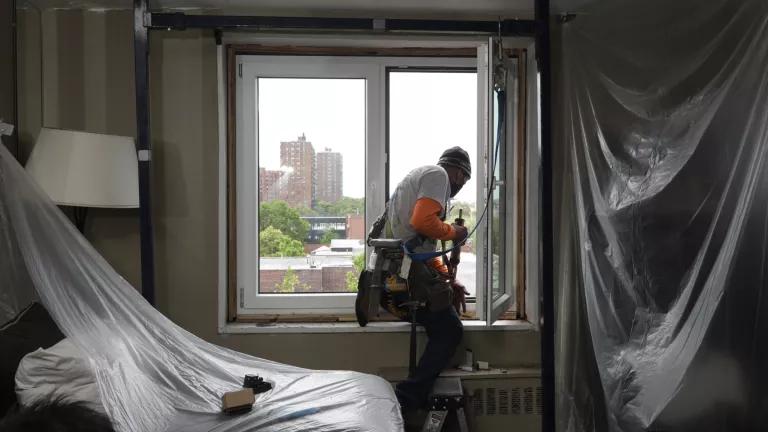Energy Efficiency in NRDC’s Commitment to Environmental Justice

Guest post by Ariadne Villegas, NRDC fellow
The people most likely to live, work, learn, and play in some of America’s most polluted and climate vulnerable environments are also most likely to be people of color, to have lower incomes, and to be targeted as hosts for pollution producing facilities. The disproportionate environmental burden on communities of color—environmental racism and injustice—is not a new phenomenon. Since the 1960’s communities of color have continued to gain traction in their efforts for cleaner air and water, habitat and species preservation, and action on climate change. These are issues that I, myself am passionate about, and ones that NRDC engages in every day. Residents have mobilized in opposition to the installation of landfills, sewage treatment plants, and other dirty industry facilities in their communities; farm workers have campaigned for better workplace rights that protect them from pesticide exposure and other occupational hazards and yet today many communities of color and lower income communities continue to be disproportionately burdened by the negative health and economic impacts of a changing climate.
To address this imbalance and advance a climate agenda that addresses climate change as the public health emergency that is, environmental justice groups have joined NRDC and other environmental groups in the creation of The Equitable and Just Climate Platform. A platform that will assure future climate policy meaningfully considers and includes the frontline and fenceline communities directly impacted by a rapidly changing climate. This platform is a commitment to a climate agenda that improves public health and well-being of all communities, while assuring it advances the goals of economic, racial, and environmental justice. This requires policies which intentionally center people, break down the health, climate, and equity siloes that have existed for too long, and that avoid replicating and reinforcing the structural inequities that many communities have been built upon.
Fortunately, many of us believe energy efficiency has the potential to be the planet’s superhero as the cheapest, fastest answer to the climate crisis—and public health experts agree. One of the biggest supporters of energy efficiency as a way to address climate change equitably is the Energy Efficiency for All (EEFA) partnership. EEFA brings together housing, health, energy efficiency, and environmental communities to collectively improve the policies and practices that provide solutions to climate change, the housing crisis, and racial injustice.
Advancing energy upgrades, especially for renters living in affordable apartments is core to the mission of the Energy Efficiency for All (EEFA) initiative. I am a strong advocate for the benefits these upgrades provide in the form of improved health and living conditions for millions of Americans through the improvement of household air quality and healthy building materials that can be part of these improvements. For a long time energy efficiency has been presented as a solution for better indoor air quality results that reduce respiratory diseases like asthma. However, the health benefits of energy efficiency extend beyond the home and the air we breathe. The benefits of energy efficiency betters housing conditions by reducing exposure to extreme temperatures, air pollution, mold, and pests—all of which have been linked to adverse health effects. Energy efficiency also preserves affordable housing, reduces the energy burden, cuts carbon pollution, and creates clean energy jobs—all of which improve health and quality of life, provide economic opportunity, and help combat the climate crisis.
To better understand the intersection of climate, health and energy efficiency, I attended the 2019 American Public Health Association Conference in Philadelphia where public health professionals presented the latest health research and information. Here, I had the chance to connect with experts from a variety of sectors on the need to advocate for better, more integrated climate and health policy. Over the course of four days I attended countless sessions, roundtables and town halls on the need for multiple solutions to the climate crisis and many of these sessions elevated the importance of clean energy and energy efficiency programs in improving health outcomes.
The “Emerging Leaders: Climate and Health Equity” panel elevated the importance of approaching climate change as a health equity issue given the need for innovative, interdisciplinary solutions to a climate emergency that is rooted in inequitable political structures, systems, and public health practices. NRDC’s Stephanie Gidigbi discussed how the Strong, Prosperous, And Resilient Cities Challenge (SPARCC) initiative is building more climate-wise communities and inclusive healthy places to address climate change, improve health equity, foster community investment without displacement, and create resilient communities for generations to come. To effectively achieve its equitable development goals, the SPARCC initiative currently engages in data collection and analysis, capital deployment, learning network support, policy reform, and communications and influence strategies all of which lead with racial equity and endeavor to create systems level change. As Stephanie stated, “when thinking of policies and practices, we must think about who benefits,” so as we continue to tackle the climate crisis, we must assure that we promote environmentally just, climate wise, and inclusive investment. We must support programs like SPARCC that promote racial equity as the driving force for igniting systems change and we must embrace tools like SPARCC’s capital screen which promotes capital investments that advance racial equity, improve health outcomes and include climate resilience planning.
Stephanie’s presentation laid the foundation for the importance of integrating climate and health policy equitably but two other presenters in particular highlighted just how important energy efficiency is for advancing climate policy that is equitable and just.
One of the first presenters to make the case for energy efficiency was the Environmental Protection Agency’s (EPA) Emma Zinmeister who proposed advancing clean energy as a public health strategy to address climate change and improve health equity. Emma stated that clean energy presents “an opportunity to advance outcomes with health equity” given the threat of air pollution as the 8th-leading risk factor for mortality in the United States and given the direct link between our energy choices and emissions that fuel climate change.
Emma discussed the air quality benefits of energy efficiency and renewable energy from reducing our reliance on fossil fuel generating power plants. Emma also presented on the use of the EPA’s AVERT tool, which provides a way that policy makers and advocates can estimate health benefits of energy programs by quantifying the benefits from avoided emissions (from criteria pollutants particulate matter (PM2.5), nitrogen oxides (NOx), sulfur dioxide (SO2), and carbon dioxide (CO2)). These air quality improvements are especially valuable to communities that already face high levels of toxic air contaminants and who are underserved by energy efficiency and clean energy programs. We know that the same households experiencing poor air quality are also likely to experience poor housing quality and higher energy burdens which adversely impact their health. To assure that we are bringing the benefits of energy efficiency and renewable energy to low-income communities we must support programs like EPA’s Clean Energy Initiative and Energy Efficiency for All which assure that we manage our growing energy needs equitably to avoid contributing to a warmer planet and adverse health outcomes all while saving residents money and strengthening the economy.
Diana Hernadez, assistant professor at Columbia University Mailman School of Public Health explained her research on the intersection between energy security and the built environment, poverty/equity, and health. A dedicated housing and energy advocate, Dr. Hernandez emphasized the importance of energy as a social and environmental justice issue. Her research has explored the connection of energy burdens and energy security with race and socioeconomic status particularly highlighting how African Americans are most impacted by energy burdens and utilities hardship—African Americans are three times more likely to experience a utility service shut-off than non-blacks (15% versus 4%). Reducing the cost of energy through utility bill assistance and energy efficiency programs help address the increased costs, decreased comfort, and adverse physical and mental health outcomes that disproportionately impact low income communities of color. Energy efficiency programs not only provide economic opportunities that reduce unhealthy coping strategies caused by energy insecurity but improve access to economic security for vulnerable communities who have been historically excluded from accessing socioeconomic opportunity, wealth accumulation, and safe, secure and energy efficient housing. Recently, Diana and EEFA’s Jamal Lewis made the argument that investing in policies that provide energy efficiency and weatherization assistance which go beyond energy bill assistance is extremely important for achieving energy justice that provides long-term and equitable solutions to energy insecurity and restorative justice.
EEFA is also working to foster social equity by enabling low-income families and households of color who live in multifamily housing to access energy efficiency and its many benefits. We have committed to taking action on climate change through energy efficiency and luckily the public health community is supporting and contributing to the development and expansion of tools for action. The American Council for an Energy-Efficient Economy’s State Energy Efficiency Scorecard report and interactive database highlight the best practices for promoting energy efficiency such as New York’s recent expansion of their building energy disclosure law to include residential property thus allowing for better consumer information. Similarly, tools like the Enterprise Greening Guideline and the Stewards of Affordable Housing for the Future report and Resident Benefits Indicator should guide the development of a climate agenda that leads with energy justice and centers the voices and positions of EJ frontline and fenceline communities, a commitment NRDC has made as coauthor and inaugural signatory of the Equitable and Just National Climate Platform.
We know that climate change has and will continue to exacerbate the environmental, economic, social and health vulnerabilities throughout the country. But we also know that energy efficiency can cut pollution, increase economic opportunity, support the transition to clean energy, and improve health so as we move forward in combating the greatest threat to my generation I am proud to take part in an initiative that connects climate, health, and racial equity in the fight for secure and healthy housing and a clean and safe environment for all.




